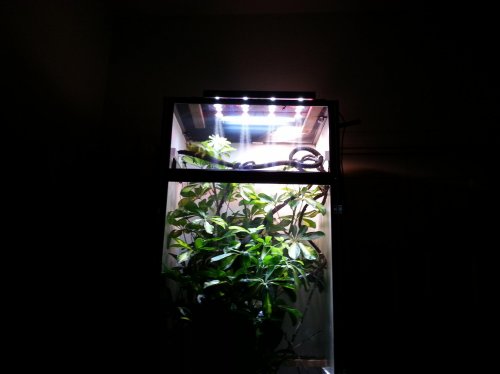jajeanpierre
Chameleon Enthusiast
I picked up my young male Trioceros q. quadricornis late December 30th directly from the importer.
He's definitely been drinking as I have found nice white urates a couple of times. I have yet to find any stool. His enclosure is jammed with two bushy umbrella trees, so they could be hidden in the leaves.
I know he has eaten at least two crickets since he arrived because I saw him eat two the second day I had him. I think there are less crickets in the enclosure than I've put in. I can only find the odd small dead one.
The shipment arrived from Cameroon mid December. Others on this forum have quads from the same shipment and found them loaded with parasites. I wormed him yesterday with Panacur. He seems to be holding his weight. He was 36 grams the night I brought him home, 40 grams a couple of days later after drinking a lot and 39 grams today. (I know--leave him alone!)
I'll follow up with fecal checks, but the consensus of the breeding cooperative who bought a large group was to worm him asap as the parasite load was extremely heavy.
He seemed to cope well with the worming yesterday, and I saw him drinking shortly after I put him back in the cage.
I've offered him some roaches in a yogurt cup high in his cage but he has ignored them. I've left them there since the day after he arrived but took them out today to feed them up to offer to him some other time. He'll eat them or I'll dispose of them (worried about parasite/disease transmission).
Do I just leave him alone and let him figure out his new life?
As I put that question mark on the above sentence, I heard a snap, looked up to see a cricket being snatched up by him. So, he is eating even if I haven't found any stool.
I still would like some advice on getting him to eat more. He is on the thin side. Other than the obvious advice of leave him alone (which is killing me to follow), what can I do to encourage him to eat more? Should I try to catch some big flies? I had my veileds outside for sun yesterday and the female was in heaven snatching up some flies. Should I worry about salmonella with the flies since I have chickens free ranging in my yard?
Thanks for any tips on getting this boy settled into his new life in captivity.
He's definitely been drinking as I have found nice white urates a couple of times. I have yet to find any stool. His enclosure is jammed with two bushy umbrella trees, so they could be hidden in the leaves.
I know he has eaten at least two crickets since he arrived because I saw him eat two the second day I had him. I think there are less crickets in the enclosure than I've put in. I can only find the odd small dead one.
The shipment arrived from Cameroon mid December. Others on this forum have quads from the same shipment and found them loaded with parasites. I wormed him yesterday with Panacur. He seems to be holding his weight. He was 36 grams the night I brought him home, 40 grams a couple of days later after drinking a lot and 39 grams today. (I know--leave him alone!)
I'll follow up with fecal checks, but the consensus of the breeding cooperative who bought a large group was to worm him asap as the parasite load was extremely heavy.
He seemed to cope well with the worming yesterday, and I saw him drinking shortly after I put him back in the cage.
I've offered him some roaches in a yogurt cup high in his cage but he has ignored them. I've left them there since the day after he arrived but took them out today to feed them up to offer to him some other time. He'll eat them or I'll dispose of them (worried about parasite/disease transmission).
Do I just leave him alone and let him figure out his new life?
As I put that question mark on the above sentence, I heard a snap, looked up to see a cricket being snatched up by him. So, he is eating even if I haven't found any stool.
I still would like some advice on getting him to eat more. He is on the thin side. Other than the obvious advice of leave him alone (which is killing me to follow), what can I do to encourage him to eat more? Should I try to catch some big flies? I had my veileds outside for sun yesterday and the female was in heaven snatching up some flies. Should I worry about salmonella with the flies since I have chickens free ranging in my yard?
Thanks for any tips on getting this boy settled into his new life in captivity.







